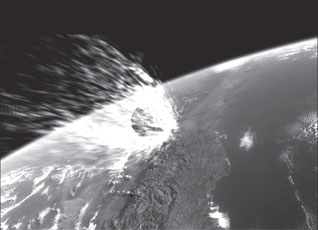A close call
 We are living on one big spaceship called Planet Earth. We are going
on a cosmic journey in space with no final destination. We share our
little corner of the Milky Way galaxy with thousands of other space
objects and collisions are inevitable at some point. We are living on one big spaceship called Planet Earth. We are going
on a cosmic journey in space with no final destination. We share our
little corner of the Milky Way galaxy with thousands of other space
objects and collisions are inevitable at some point.
It is generally accepted that the extinction of the dinosaurs was
caused by an asteroid that impacted with the Earth 65 million years ago,
creating a huge crater and blocking out the sun for a long period. Their
extinction most probably helped the mammals, including Man, to evolve
and flourish. If you study a world map closely, you will see many other
hidden or partially hidden sites of asteroid impact dotted around the
world.
But we have an advantage that the dinosaurs did not have. We can
predict, with a great deal of accuracy, whether an asteroid would hit
the Earth or not. Most of you would have seen the two blockbuster movies
Deep Impact and Armageddon, which take the Hollywood approach to this
impending danger. As these movies suggest and as many scientists point
out, blasting the asteroid off or deflecting its path could be one
answer if we know for certain that an asteroid is on a collision course
with the Earth.
We pen these lines in the context of the rather close calls the Earth
had with two different space objects last week. In the first incident,
more than 1,000 people were injured in Russia when a 17-metre space
object fragmented upon entering the Earth’s atmosphere. On the same day,
a 45-metre diameter asteroid named 2012 DA14 whizzed harmlessly past the
Earth, but it was very, very close call by cosmic standards: just 27,000
Km. In fact, many of our artificial satellites are placed much further
out.
Both events show just how vulnerable we are to a “space attack” - not
by aliens, but by alien objects such as asteroids. And there is no
guarantee that we will always know about them in advance. While 2012
DA14’s path was well known for over a year (it was discovered last year
by a Spanish amateur astronomer), the one that exploded over Russia was
an unexpected, unknown object. But even 2012 DA14 would not have been
detected just 10 years ago. Technology has marched on to the point where
we can pinpoint even small objects headed our way, but there is still
room for improvement as the Russian incident shows.
A collision with a big asteroid will be catastrophic for life on
Earth. DA14 was travelling at 28,500 Km/h when it flew by Earth -
imagine the sheer impact an object the size of a football field would
create when it hits the Earth at that speed. It could easily wipe out a
major city or region, but the repercussions will be felt worldwide.
Orbit
It is not very comforting to know that around half a million similar
objects are buzzing around in our galactic neighbourhood. Thankfully,
NASA has already discovered and catalogued around 95 percent of the
asteroids of a kilometre or more in diameter that are in the Earth's
orbit around the sun and capable of causing mega-destruction.
 |
|
An asteroid |
The NEO program at NASA currently detects and tracks
Earth-approaching asteroids and comets with land-based and orbiting
telescopes. Scientists estimate their mass and orbit to gauge whether
they pose a danger. NASA is also financing a project at the University
of Hawaii called Atlas, or Asteroid Terrestrial-Impact Alert System.
Researchers say ATLAS, which will monitor the entire visible sky every
night, will be able to detect objects 45 metres in diameter at least a
week before they hit our planet.
For those measuring 150 metres in diameter, the system, which could
be operational in late 2015, will give a three week warning. According
to the researchers, the sensitivity is roughly equal to detecting a
match flame in New York City when viewed from San Francisco.
At least one week’s warning will be necessary “to evacuate the
area[to be hit by the asteroid], take measures to protect buildings and
other infrastructure and be alert to a tsunami danger generated by ocean
impacts,” according to the ATLAS website.
A private foundation called B612 is also trying to raise US$450
million to build and deploy a space telescope called Sentinel and placed
in orbit around the sun, at a distance of 273 million kilometres from
the Earth to detect most objects that are otherwise not visible.
But what can be done to prevent a collision, should these probes find
an asteroid that would cross paths with the Earth? There are several
proposals, some of which are already within reach of modern technology.
A nuclear attack is Hollywood’s way of doing it, but it is also
scientific.
Another school of thought is that we can deflect an asteroid by
sending an unmanned space missile to nudge it without necessarily
destroying it - a mere 1.6 kilometre-per-hour impact would be enough to
divert an asteroid by 273,000 kilometres if we hit it 20 years before
the predicted collision. Another idea is that strategically positioned
mirrors could concentrate solar rays, heat a small portion of an
asteroid's surface, and cause it to spew vapours. As this material
ejects from the asteroid, it would provide a little thrust to alter the
space rock's path.
Apophis
There are many more plans, some of which sound far-fetched, but
there’s no denying that we do have the technology to prevent an
asteroid-Earth collision if we know about it in advance. A 320 metre
wide Asteroid called Apophis will be making close calls in 2029 and 2036
and scientists will have a chance to see whether any of these approaches
could work.
But asteroids are not all bad news. Many asteroids could be home to
vast deposits of precious metals that could one day be harnessed using
methods which are yet to be discovered or invented. NASA and other space
agencies will be sending several robotic probes to asteroids to study
their surface make-up. A manned mission to an asteroid cannot be ruled
out.
Along with meteorites and comets, they might even hold the key to
resolving questions on the origin of life and whether life could exist
outside of Earth. This theory on the extra-terrestrial origins of life
was very much in the news recently following the discovery of meteorite
fragments in several parts of Sri Lanka.
Vigilance, they say, is the best form of defence and security. And so
it pays to literally keep an eye on the sky at all times. That tiny
fragment you see in the night sky could be an unidentified asteroid.
Saving the Earth from destruction could start from that simple
discovery.
|



